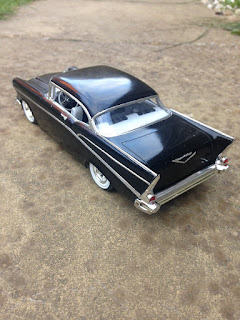Old-School Cool
If you read this earlier post, you will remember how much fun I had building the AMT
Ford F-100 pickup as a tired, worn-out old work truck, and I said there must be
so many more ways to build it using just the included parts. Well, I couldn’t
resist building another one, and this time I used some of the custom parts to
make an old-school custom truck.
The kit in question is again the Round2 reissue of the old
AMT 1953 Ford F-100 Pickup, again purchased from Rochester Games & Models. I summarised the kit contents in my earlier post but I will say again that the sheer choice of optional parts makes this kit so
much fun. Quality is OK - it’s not the latest standard in terms of fit and
detail, but you shouldn’t run into any serious problems anywhere. The tyre
whitewalls are also supplied ready-done, which is nice.
This time I built the kit to recreate a 1960's custom
machine, representing somebody’s faithful pickup truck which they have decided
to turn into an eye-grabbing custom car. Just like with new cars, which go in
and out of fashion over the years, so it is with modified cars: the custom cars
being created today don’t look much like the ones being created in the 1980's,
which in turn looked different to what custom cars looked like in the 1960's. In
1960's America, deep metallic paint on the body and chrome on everything else
was very much the order of the day, and that’s what I have attempted to recreate
with this kit. All the parts used are included in the box, from the
bullet-shaped over-rider bumpers to the lovely chrome dished wheels. I lowered
the suspension by simply removing a chunk from each of the spring mountings, giving the
truck a tough-looking low-down attitude. I fixed the bonnet/hood shut,
saving the engine for a future project.
I spent a great deal of time on the paintwork of this truck,
knowing that flawless paint is key to a good 1960's custom car, and to be honest
the result is not what I intended. I began by priming the body panels in white
primer, followed by a good smooth coat of silver paint which I gently
sanded/flatted to provide a smooth finish. I then applied a light coat of Ford
Pepper Red metallic paint over the silver, hoping that this would give a custom
or ‘candy’ look, followed by many coats of lacquer. This done, I gently
wet-sanded the lacquer and polished it with some G3 cutting compound, followed
weeks later by a buff with some genuine Meguiars Gold Class car wax. The end
result? Basically metallic red paint, pretty much as it would have looked
straight out of the can and without all the fuss! In some places, thanks to all
my smoothing and polishing, the red has rubbed through revealing the silver
beneath, which is a shame. Still, at least it is pretty smooth and I think the
Ford Pepper Red, despite being new, suits the old truck well.
The interior was left simple, with just a coat of white primer
for the bench seat and dashboard, and matt black to simulate rubber matting on
the floor. Sadly I somehow managed to smudge the inside of the windshield,
probably while I was fixing the rear view mirror in place, but it isn’t too
noticeable. There is also a flashy chrome gear lever in front of the seat, a
typical 1960s custom touch. The wooden pickup bed was simulated my simply
rubbing a thin smear of brown oil paint over silver paint.
































